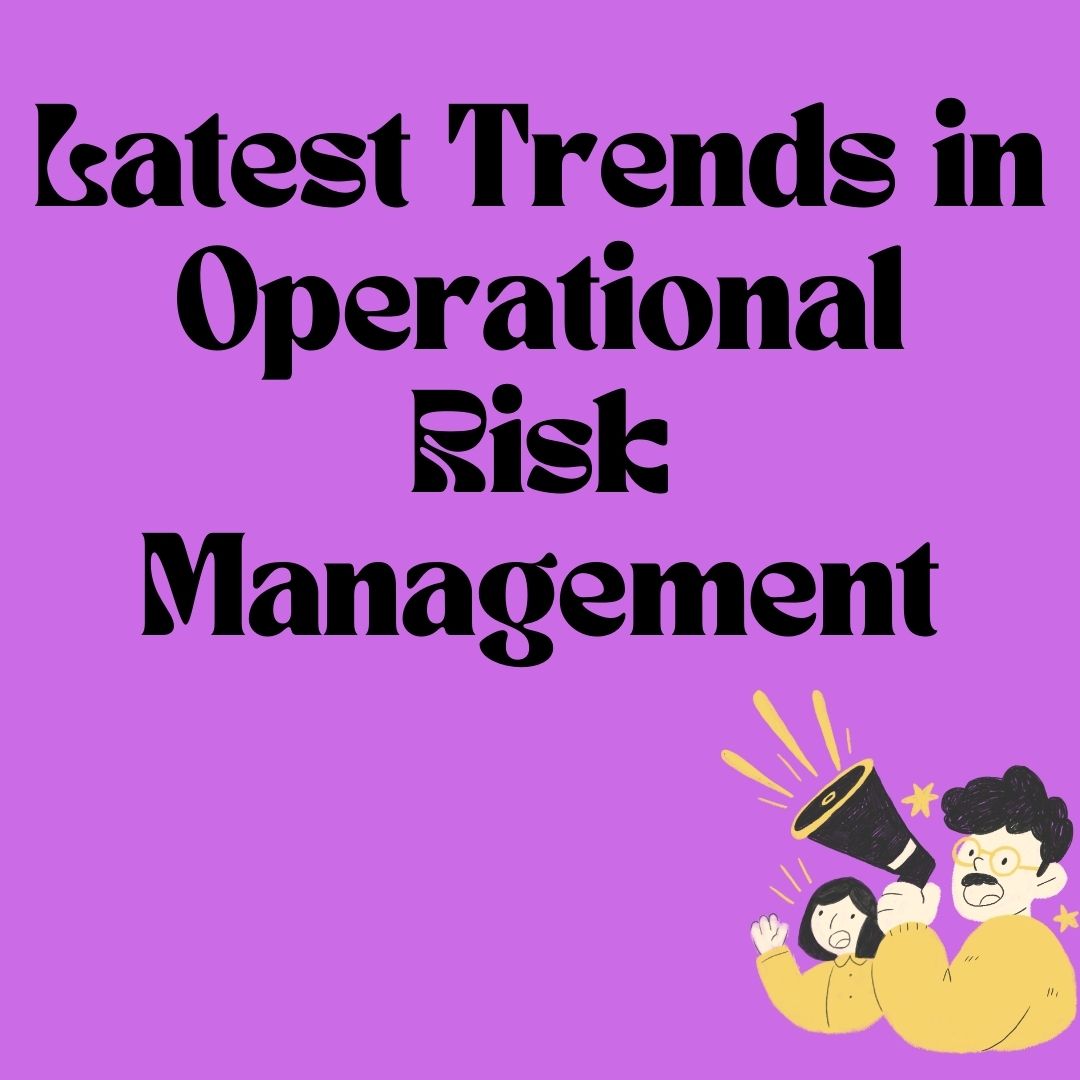Navigating the Maze: Latest Trends in Operational Risk Management
- 22 December 2023 | 919 Views | By Mint2Save

Operational risk, the constant spectre of business disruptions and financial losses, has undergone a fascinating evolution in recent years. No longer a static checklist of internal hiccups, it now reflects the dynamic interplay of external shocks, digital transformations, and evolving regulatory landscapes. To navigate this evolving landscape, organizations need to stay abreast of the latest trends shaping operational risk management.
1. Cybersecurity Ascending: No surprise here, cybersecurity remains the undisputed champion of operational risks. The frequency and sophistication of cyberattacks are escalating, targeting vulnerable systems and exploiting digital vulnerabilities. Organizations are shifting their focus from pure prevention to building resilience, embracing incident response plans, and investing in threat intelligence. Advanced detection tools powered by AI and machine learning are becoming vital, along with robust data security and access controls.
2. Third-Party Tango: As outsourcing complexities rise, managing third-party vendors is a growing concern. The domino effect of a single third-party breach can be crippling, highlighting the need for stringent vendor selection, thorough risk assessments, and continuous monitoring. Building robust contractual frameworks with clear risk allocation clauses is crucial. The future lies in adopting collaborative risk management with key vendors, leveraging shared data and insights to proactively identify and mitigate threats.
4. Climate Change Conundrum: Operational risks related to climate change are no longer hypothetical. Extreme weather events, resource scarcity, and changing regulations are forcing organizations to adapt. Companies are integrating climate risk assessments into their operational protocols, building resilient infrastructure, and diversifying supply chains to weather disruptions. Embracing renewable energy sources and resource-efficient practices are becoming business imperatives, not just environmental gestures.
5. Automation Avalanche: The automation revolution is reshaping operations, introducing new risk dimensions. While automation promises efficiency and reduced human error, it also brings vulnerabilities through system failures, algorithm biases, and dependence on technology. Organizations are building risk-aware automation frameworks, employing rigorous testing and validation procedures, and establishing clear human oversight mechanisms. Embracing continuous monitoring and adaptive algorithms is crucial to mitigate potential downsides.
6. Big Data Bonanza: Data is the new gold, but its immense potential brings corresponding risks. Data breaches, privacy violations, and algorithmic biases pose significant operational threats. Organizations are implementing robust data governance frameworks, employing advanced data encryption techniques, and ensuring compliance with evolving data privacy regulations. Transparency and responsible data usage are becoming key differentiators in a data-driven world.
7. Talent Tightrope: The global talent war is intensifying, creating operational risks from skills gaps and employee turnover. Investing in employee training and development is crucial to build a future-proof workforce. Fostering a culture of risk awareness and empowering employees to report hazards will strengthen internal risk management. Additionally, organizations are exploring alternative talent sourcing strategies and leveraging automation to address critical skill shortages.
8. Remote Revolution: The pandemic ushered in a new era of remote work, presenting unique operational challenges. Managing dispersed teams, ensuring data security in remote environments, and preventing burnout are key concerns. Organizations are building strong communication channels, investing in collaborative tools, and fostering trust-based virtual work cultures. Embracing flexible work models and promoting employee well-being are essential for long-term success in a remote-first world.
9. Resilience Reimagined: The focus on operational resilience has taken center stage. Organizations are building contingency plans for diverse scenarios, from cyberattacks to supply chain disruptions. Investing in redundant systems, diversifying suppliers, and conducting regular stress tests are crucial for weathering unforeseen shocks. Continuous scenario planning and adaptation are becoming key pillars of operational resilience.
10. Proactive Prognosis: Operational risk management is no longer a reactive exercise. Leveraging AI and machine learning, organizations are adopting predictive analytics to identify and anticipate potential risks before they materialize. By analyzing historical data, identifying patterns, and simulating potential scenarios, organizations can proactively allocate resources and implement targeted mitigation strategies.
In conclusion, navigating the evolving landscape of operational risk requires a dynamic and multifaceted approach. Embracing these latest trends will equip organizations to weather the storms, build operational resilience, and safeguard their long-term success in an increasingly uncertain world. Remember, operational risk is not a destination, but a continuous journey of adaptation and innovation.
From Theory to Practice: Strategies for Implementing Trending Risk Management Approaches
While understanding the latest trends is crucial, the real value lies in their practical application. Let’s explore ways to implement these trends into your risk management framework:
1. Building Cybersecurity Fortresses:
- Embrace a “defense in depth” approach: Layering multiple security measures across your systems, from strong passwords and access controls to intrusion detection systems and incident response plans.
- Invest in threat intelligence: Stay updated on the latest cyber threats and vulnerabilities through industry reports and collaboration with security experts.
- Conduct regular penetration testing: Simulate cyberattacks to identify and patch vulnerabilities before malicious actors exploit them.
- Educate your employees: Train your workforce on cybersecurity best practices to minimize human error risks.
2. Mastering the Third-Party Dance:
- Develop a robust vendor selection process: Evaluate potential vendors’ risk management practices, security protocols, and track record of data protection.
- Include clear risk allocation clauses in contracts: Specify who is responsible for different types of risks associated with the third-party relationship.
- Conduct regular risk assessments of your vendors: Continuously monitor their performance and compliance with agreed-upon security standards.
- Foster open communication and collaboration: Establish clear channels for information sharing and proactive communication of potential risks with your vendors.
3. Weathering the Climate Change Storm:
- Integrate climate risk assessments into your strategic planning: Identify climate-related vulnerabilities in your operations, supply chains, and infrastructure.
- Invest in climate-resilient infrastructure: Design and build facilities and systems that can withstand extreme weather events and resource scarcity.
- Diversify your supply chains: Reduce dependence on single source regions or providers vulnerable to climate change impacts.
- Embrace sustainable practices: Implement resource-efficient processes and renewable energy solutions to minimize your environmental footprint and enhance operational resilience.
4. Riding the Automation Wave:
- Develop comprehensive automation testing and validation procedures: Ensure automated systems perform as intended and don’t introduce new vulnerabilities.
- Establish clear human oversight mechanisms: Maintain human control over critical decision-making and intervene when necessary.
- Implement continuous monitoring and feedback loops: Monitor the performance of automated systems for potential glitches or biases and regularly update algorithms to improve their accuracy and efficiency.
- Invest in upskilling and reskilling programs: Equip your workforce with the skills needed to manage, monitor, and interact with automated systems effectively.
5. Harnessing the Big Data Boon:
- Implement robust data governance frameworks: Establish clear guidelines for data collection, storage, use, and deletion to ensure compliance with regulations and minimize privacy risks.
- Invest in data security technologies: Encrypt sensitive data and implement access controls to prevent unauthorized access or breaches.
- Build a culture of data privacy: Sensitize employees about data protection and responsible data usage practices.
- Embrace transparency and accountability: Be open about your data collection practices and allow individuals to access and control their data.
Beyond the Trends: Industry-Specific Considerations
While the presented trends apply broadly, specific industries face unique operational risks. Here are some industry-specific considerations:
- Financial Services: Cybersecurity and data privacy remain paramount, while regulatory compliance and fraud prevention are key concerns.
- Healthcare: Patient data privacy and security are critical, along with managing risks associated with medical equipment failures and medication errors.
- Manufacturing: Supply chain disruptions, equipment malfunctions, and workplace safety hazards are crucial considerations.
- Technology: The rapid pace of innovation brings risks related to data breaches, algorithm biases, and intellectual property theft.
Read about Correlation and Causation: Untangling the Threads of Influence
Moving Forward: A Continuous Journey
Operational risk management is not a one-time fix; it’s a continuous journey of adaptation and improvement. By embracing the latest trends, tailoring them to your industry and organizational context, and fostering a culture of risk awareness, organizations can navigate the dynamic and ever-evolving landscape of operational risk with greater confidence and agility. Remember, preparedness is the key to weathering any storm, and proactive risk management is the compass that guides us through the ever-shifting maze of operational risks.
Google’s Operational Risk Strategy: A Glimpse into the Mountain View Maze
Google’s operational risk strategy exemplifies a forward-thinking and data-driven approach to navigating the complex maze of threats in today’s digital world. By leveraging its strengths in technology, analytics, and collaboration, Google has established itself as a leader in operational risk management, offering valuable lessons for organizations of all sizes and industries. Let’s have a look on the same.
As a tech giant with global reach and complex operations, Google faces a diverse and dynamic landscape of operational risks. From data breaches and cybersecurity threats to disruptions in the supply chain and evolving regulatory landscapes, navigating this multifaceted maze requires a robust and innovative risk management strategy. Here, we take a peek into Google’s approach to operational risk, uncovering the key pillars that contribute to its success:
1. Data-Driven Decisions: Google leverages its vast data resources and expertise in analytics to inform its risk management decisions. Machine learning algorithms continuously analyze internal and external data to identify potential risks, predict their likelihood and impact, and prioritize mitigation efforts. This data-driven approach allows Google to stay ahead of emerging threats and allocate resources effectively, fostering a proactive and preventative risk culture.
2. Multi-Layered Security: Recognizing the omnipresent threat of cyberattacks, Google has fortified its infrastructure with a multi-layered defense system. From advanced encryption technologies and zero-trust architecture to automated threat detection and incident response protocols, Google continuously invests in cutting-edge security solutions. This layered approach makes it challenging for malicious actors to penetrate the system, minimizing the potential for data breaches and operational disruptions.
3. Embracing Openness and Transparency: Google actively promotes transparency and open communication across the organization regarding operational risks. Regular risk assessments and reports are shared at various levels, empowering employees to identify and report potential hazards. This fosters a culture of collective responsibility, where everyone plays a role in mitigating risks and ensuring operational resilience.
4. Prioritizing Supply Chain Resilience: Recognizing the vital role of its supply chain in delivering products and services, Google focuses on building resilience and mitigating risks throughout its network. This includes diversifying suppliers, ensuring ethical sourcing practices, and continuously assessing potential vulnerabilities in the supply chain. Additionally, Google collaborates with partners and industry experts to develop proactive strategies for managing supply chain disruptions, ensuring smooth operations even in unforeseen circumstances. The Greening of Greed: A Deep Dive into the Green Investment Boom
5. Regulatory Agility: As legal and regulatory landscapes constantly evolve, Google remains nimble and adaptable to comply with changing requirements. Dedicated teams stay informed about emerging regulations and proactively assess their potential impact on Google’s operations. This enables Google to implement necessary changes and comply with new regulations promptly, minimizing operational risks associated with non-compliance.
6. Innovation for Risk Mitigation: Google doesn’t merely mitigate risks; it actively uses innovation to transform the risk landscape itself. From utilizing AI and machine learning for enhanced cybersecurity to developing tools for proactive risk identification and management, Google focuses on creating solutions that not only address current risks but also anticipate and prevent future ones. This forward-thinking approach positions Google as a leader in operational risk management, setting the industry benchmark for innovative solutions.
7. Culture of Continuous Improvement: At Google, operational risk management is not a static process but a continuous cycle of learning and improvement. Regular evaluations of existing risk management practices, post-mortem analyses of incidents, and collaboration with industry experts ensure that Google constantly refines its approach. This ongoing commitment to improvement allows Google to stay ahead of the curve and adapt to the ever-changing risk landscape.









